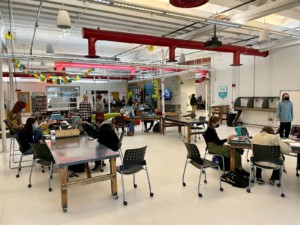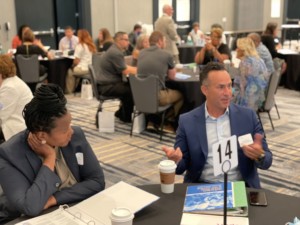How to Work Together to Build Capacities for Collaboration

Having challenged, in my previous post for Getting Smart, some of the common notions we educators share about collaboration, I acknowledge that it is only fair that I take some time to wrestle with what collaboration really means and why it is so important as we prepare our students for the future.
Definition of True Collaboration
First, let’s get our definitions straight. Collaboration is not cooperation, though it may involve the good will of such a stance. Collaboration is not productivity assembly-line style, where each participant in a group activity does an assigned task and never interacts with others – though collaboration may be involved in designing efficient ways for accomplishing menial tasks. Collaboration is not mere delegation of those jobs, either. So, where does that leave us?
The Association for Image and Information Management (AIIM) defines collaboration as “a working practice whereby individuals work together to a common purpose to achieve business benefit.” Of course, we all know that “working together” is the tricky part, isn’t it? And we also know that the practice of collaboration isn’t necessarily just for business, though we may need to think about what “business benefit” may mean for our students down the road. Breaking down this practice further as a “collaboration lifecycle,” AIIM claims that collaboration is a circular process that incorporates awareness, motivation, self-synchronization, participation, mediation, reciprocity, reflection, and engagement. Now, these are skills or habits I can certainly begin to wrap my head around as a teacher and promote in my work with students.
Further, the Partnership for 21st Century Skills places collaboration among the “4 Cs” we need to instill in our students. Under the broader heading of “Learning and Innovation Skills,” the 4 Cs include critical thinking, communication, collaboration, and creativity. The Partnership elaborates that our students need to be able to:
- Demonstrate ability to work effectively and respectfully with diverse teams
- Exercise flexibility and willingness to be helpful in making necessary compromises to accomplish a common goal; and
- Assume shared responsibility for collaborative work, and value the individual contributions made by each team member. (Partnership for 21st Century Skills, “Overview: Communication and Collaboration”)
The words effectively, respectfully, and diverse jump out at me. Collaboration implies a range of opinions and approaches, not a herd of compliant sheep “bahhing” contentedly at one another. The attitude of respect for divergent opinions and how they can ultimately strengthen the outcome of a collaborative venture seems crucial to me.
Respect is also a verb, we must remember, an action we must actively adopt to allow collaboration to take place. Flexibility and helpfulness are character traits we must embody and teach in order to facilitate collaboration, as is the concept of taking responsibility. However, I must admit that all are easier to pay lip service to than to inculcate in children whose brains are developing as we teach them. I also worry about how we have become enmeshed in a culture that celebrates willfulness, snarky comments (see Ramin Setoodeh on our “culture of meanness” at The Daily Beast), and weaseling out of things. I know I need to seek more effective ways of teaching the qualities, habits, and capacities that can lead to true collaboration.
I learned a lot from Meta Collab, an uber-resource set up as a wiki (a collaborative online tool) to allow for collaboration on the topic of collaboration. The Meta Collab general page on “Collaboration” led me to a list of “Attributes of a Collaborator” compiled by the Institute for Distributed Creativity, which includes, among other sensible directives: “Get everybody involved in the process;” “Develop good listening skills;” and “Learn when to let go.” Teachers and others could make good use of this list of qualities, I would think, in pre-project discussions, mid-point evaluations, or reflective self-assessments as ways of helping students learn how to collaborate meaningfully.
Examples of Quality Collaboration
Certainly some tools, by their nature, encourage collaboration. I’ve already mentioned wikis, and many of us have begun to embrace the collaborative potential Google Docs, Google Hangout, or Skype. Via Twitter, we can find thinkers from all walks of life negotiating and refining the meaning of any term we care to look for, including #collaboration.

I found a wonderful example of collaboration on Steve Hargadon’s blog as he enlisted last October the help of readers to design presentations for next week’s SXSWedu conference. He reports that this exchange generated “plenty of good contact, enough to generate three sessions” for the conference.

The Globe Program hopes to inspire the “next generation of scientists” by enlisting students in partner schools in data collection for NASA, NOAA, and the National Science Foundation, as well as in projects to create public awareness about climate change.
The Ushahidi project (ushahidi meaning “testimony” in Swahili) began as a way to map incidents of violence in Kenya in 2008 and has gone on to involve students and activists around the world in using open source crowd-sourcing software to address crises such as the aftermath of the recent earthquakes in Haiti and Japan and the ongoing conflict in Syria. The Ushahidi crowdmapping system has also been used by students to imagine “The Future of Cities and Education” in New York City.
If educators need further inspiration for how to empower their students with true collaborative skills, they need look no further than John Hunter’s World Peace Game on TED.
In an effort to walk the walk I advocate in this post, I have created a Pinterest board on “Collaboration” for many of these sources and would welcome contributions and comments from readers. (Share your resources in a comment to this page, and I will add them to the board; share your email address, and I will add you as a contributor.)
Why Collaboration Matters
I now better understand that collaboration is really about learning, and in particular it is about learning not just inside our own heads, but through our engagement with others who can challenge us, stretch us, and teach us.
Bill Cushard, in a 2010 blog post, “Three Critical Skills Learning Professionals Need Now,” urged his readers to “Start using collaboration tools – of any kind.” In Future Work Skills 2020, the Institute for the Future for the University of Phoenix Research Institute (now the Apollo Research Institute) catalogs “Ten Skills for the Future Workforce.” “Virtual Collaboration,” defined as “the ability to work productively, drive engagement, and demonstrate presence as a member of a virtual team,” is number 10. Teachers need to step up and design opportunities for students to practice these skills in school both in face-to-face and in online settings.
We all need to identify and overcome the obstacles to collaboration that ultimately inhibit our growth as learners. Ironically, we must sit down together (virtually and digitally), join the conversation, and share transparently in order to create the kind of environment where real collaboration can happen.







Suzie Nestico
Susan,
This is a great post! The theme of cooperation vs. collaboration has been rearing its head here for me for the past several days and I'm trying to figure out why. I couldn't agree more with thoughts above and I do believe that unfortunately, there's are often times that people in education confuse or interchange cooperation and collaboration. While some similarities exist, there are no doubt grave differences. I've written about the same before, trying to convey a similar message to you're above http://coalcrackerclassroom.wordpress.com/2011/06/28/connecting-cooperating-collaboration/ .
Thanks for an even more informative post!
Susan Davis
Thanks for sharing your post, Suzie. You have added to my thinking with your points about addressing big ideas and being purposeful when collaborating.